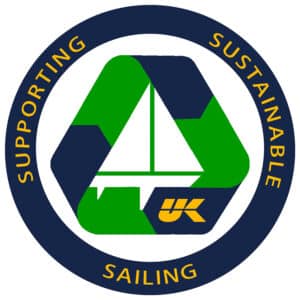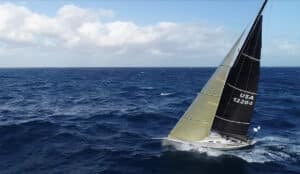UK Sailmakers’ customer Iain Simpson has developed a sail management system that allows cruising sailors to put up one set of sails at the beginning of the season that can be used in all winds all season long. As Simpson explains in the following article, his “Simbo Rig” allows cruising couples to safely and comfortably sail bigger boats:
The Simbo Rig is the abbreviation for Simple Bow Rig, which I devised for short handed cruising sailors who are sailing larger and more powerful yachts on longer passages. The merit of the rig is that it enables a short-handed crew to sail efficiently and safely dead downwind without resorting to colored sails. The working rig is always at hand making easy course corrections to avoid collision or bringing the yacht to weather to retrieve a MOB.
I have always felt that the average cruising sailor is distracted by the needs of the racing fraternity and, as a result, becomes drawn into systems and technical equipment that are not entirely appropriate. The Simbo Rig ideas were developed over 65 years of cruising the Atlantic and Mediterranean coasts of Europe plus six trans-Atlantic crossings.
The Simbo Rig is centered around flying identical twin jibs with their higher cut clew and 106% overlap. This enables the short handed cruising yachtsman to sail efficiently on all points of the wind with minimum foredeck work, controlled from the security of the cockpit. Simbo Rig also eliminates the need for larger, overlapping jibs.
Apart from the raising and stowing of the whisker poles, no foredeck work is required; and, with in-mast mainsail and jib furling, one person can control the rig from the security of the cockpit day and night, in fair or foul weather, without calling upon off-watch crew (assuming of course, that the yacht is under the control of a reliable auto-pilot).
The Simbo Rig system has two identical jibs hoisted up the twin grooves of a furling forestay on a single halyard and can be used with one or two whisker poles. The sails always fly together. Our jibs and in-mast furling mainsail were designed by UK Sailmakers made out of Dimension Polyant’s HydraNet woven cloth, which is a hybrid of woven polyester with a Spectra ripstop. Going upwind, the two sails lay against each other.
When tacking, I release the inside jib’s sheet first, which leaves only one sheet to be released when coming through the wind. Once through, the new outside jib is sheeted first, while the inside sail lays quietly against the outside jib. The inside jib’s sheet can be tweaked last. When reefing or striking the jibs, both sails furl together around the forestay the same way as a solo jib. As both sails have their own set of sheets, there is double the quantity of line in the cockpit, but this can be simplified by color coding.
The magic of the system comes into play when the yacht bears away to a run. The two sails separate to their respective side of the yacht to create a powerful wall of sail. I found that when the main boom is eased to 45-degrees off center, the wind flows off the main into the windward jib, which, together with its own accumulated wind, is redirected into the leeward jib that would otherwise be blanketed by the mainsail. To jibe, just haul and release the mainsheet onto the new tack, leaving the whisker poles and jibs untouched.
When going onto a run, roll up the jibs. I then set one or both whisker poles in position with the sheets through the pole jaws while the boat is flat and there is no load on the sheets. On my boat I use the whisker poles in one position only, which has allowed me to mark the topping lifts, fore and afterguys for the optimal setting. Once the poles are in position, I unroll the jibs and trim the sheets. When the windward jib is pulled out to the pole, the wind deflected off the sail fills the leeward jib.
The linked video shows the twin jibs being hauled out to their respective whisker poles in 10 knots of wind from which you will note the immediate acceleration in the yacht’s speed once the apparent wind off the mainsail has joined with the following true wind in the weather jib and redirected into its leeward twin. For any further information on the Simbo Rig you may like to refer to www.rhbell.com/simbo and/or discuss the matter with UK Sailmakers.



